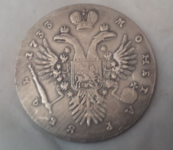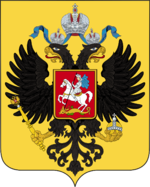Maybe, but it does match the kinds of decorative items the Russians were reknowned for producing at the time. Some history of Russian immigration from that time period to the USA, particularly White russians (loyal to the Czar) and Jewish. As with most immigrants, Scottish, German, Irish, etc, they always seemed most at home in climates that reminded them of the old country, so Russian immigrants in Michigan was a comfortable fit.
From the web:
First wave (1870–1915)
 St. Theodosius Russian Orthodox Cathedral
St. Theodosius Russian Orthodox Cathedral in
Cleveland, est. in 1896.
The first massive wave of immigration from all areas of Europe to the United States took place in the late 19th century, following the 1862 enactment of the
Homestead Act. Although some immigration took place earlier – the most notable example being
Ivan Turchaninov, who immigrated in 1856 and became a United States Army
brigadier general during the Civil War– millions traveled to the new world in the last decade of the 19th century, some for political reasons, some for economic reasons, and some for a combination of both. Between 1820 and 1870 only 7,550 Russians immigrated to the United States, but starting with 1881, immigration rate exceeded 10,000 a year: 593,700 in 1891–1900, 1.6 million in 1901–1910, 868,000 in 1911–1914, and 43,000 in 1915–1917.
[12]
The most prominent Russian groups that immigrated in this period were Carpatho-Rusyns from
Austria-Hungary who self-identified as Russians and those groups from Imperial Russia seeking freedom from religious persecution. The latter included
Russian Jews, escaping the 1881–1882
pogroms by
Alexander III, who moved to
New York City and other coastal cities; the Spiritual Christians, treated as
heretics at home, who settled largely in the Western United States in the cities of
Los Angeles, San Francisco,
[12][13] and
Portland, Oregon;
[14] two large groups of
Shtundists who moved to
Virginia and the
Dakotas,
[12] and mostly between 1874 and 1880 German-speaking
Anabaptists,
Russian Mennonites and
Hutterites, who left the Russian Empire and settled mainly in
Kansas (Mennonites), the
Dakota Territory, and
Montana (Hutterites). Finally in 1908–1910, the
Old Believers, persecuted as schismatics, arrived and settled in small groups in California,
Oregon (particularly the
Willamette Valley region),
[14] Pennsylvania, and New York.
[12] Immigrants of this wave include
Irving Berlin, legend of American songwriting and
André Tchelistcheff, influential Californian winemaker.

Russian immigrant home, New York City, 1910—1915.
World War I dealt a heavy blow to Russia. Between 1914 and 1918, starvation and poverty increased in all parts of Russian society, and soon many Russians questioned the War's purpose and the government's competency. The war intensified
anti-Semitic sentiment. Jews were accused of disloyalty and expelled from areas in and near war zones. Furthermore, much of the fighting between Russia, and Austria and Germany took place in Western Russia in the Jewish
Pale of Settlement. World War I uprooted half a million Russian Jews.
[15] Because of the upheavals of World War I, immigration dwindled between 1914 and 1917. But after the war, hundreds of thousands of Jews began leaving Europe and Russia again for the U.S., Israel and other countries where they hoped to start a new life.
[16]
Second wave (1916–1922)[edit]
Main article:
White émigré
A large wave of Russians immigrated in the short time period of 1917–1922, in the wake of
October Revolution and
Russian Civil War. This group is known collectively as the
White émigrés. The U.S. was the third largest destination for those immigrants, after France and Serbia.[
citation needed] This wave is often referred to as the first wave, when discussing Soviet era immigration. The head of the
Russian Provisional Government,
Alexander Kerensky, was one of those immigrants.

As with first and second wave, if the White émigré left Russia to any country, they were still considered first or second wave, even if they ended up moving to another country, including the US at a later time. There was no 'strict' year boundaries, but a guideline to have a better understanding of the time period. Thus 1917-1922 is a guideline. There are Russians who are considered second wave even if they arrived after 1922 up to 1948.














